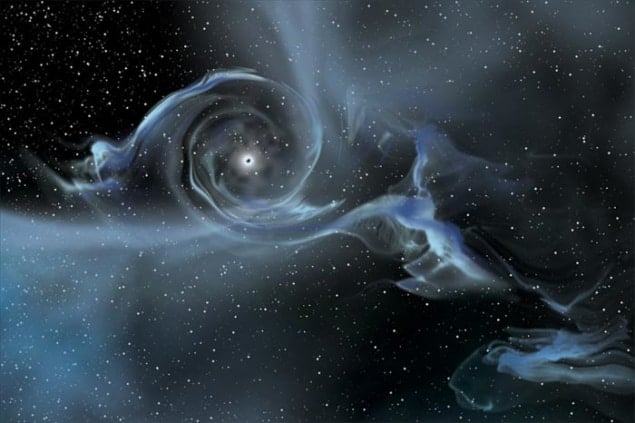
The birth of a black hole may be signalled by a characteristic cosmic flash, according to researchers in the US. It was previously thought that only the most massive of black holes would produce gamma-ray bursts – narrow beams of electromagnetic radiation that shoot out of the poles of the collapsing star – when they form. But other dying stars were thought to produce a black hole without any kind of flash – seemingly disappearing from the visible sky in an event known as an “unnova”. The US researchers’ work suggests that unnovae might also have their own characteristic flash, allowing astronomers to witness the birth of stellar- and intermediate-mass black holes.
“Although we know that black holes exist, we know very little about the observable signal that heralds the moment they first form,” says Tony Piro, an astrophysicist at the California Institute of Technology and one of the lead researchers of the new study. As a massive star reaches the end of its life it undergoes core collapse, with its component protons and electrons merging to form neutrons. Before it completes its collapse into a black hole, the star momentarily becomes a super-dense object known as a neutron star.
Telltale flash
A by-product of this collapse is the release of neutrinos, which represents a significant loss of energy/mass from the core that causes a corresponding, sudden decrease in the gravitational pull of the star. This loss of attraction has an effect on the core’s surrounding gaseous layers – which are mostly composed of hydrogen – causing them to rush outwards, forming an expanding shockwave that travels at more than three million kilometres per hour.
In a previous study from the University of California, Santa Cruz, astronomers Elizabeth Lovegrove and Stan Woosley had predicted that this shockwave would heat up the gaseous envelope, producing a characteristic glow that would shine for around a year and acting as a potential signal of the birth of such a black hole. Even though this effect would be a million times brighter than the Sun, it would still be dim in comparison with other stars. “It would be hard to see, even in galaxies that are relatively close to us,” Piro explains.
One size fits all
However, in his recent study, Piro has identified another signal that should be easier to detect from the Earth – an initial flash generated by the shockwave as it hits the star’s outer layers. For a red supergiant progenitor star, this breakout flash should be 10–100 times brighter than the glow predicted in Lovegrove and Woosley’s study – with peak wavelengths in the ultraviolet and visible spectrum – and would be observable in nearby galaxies. Piro tells physicsworld.com that if the new flash in detected, it will reveal “the formation of black holes of all masses, offering a new approach from which to study these extraordinary gravitational phenomena”.
Chris Reynolds, a professor of astronomy at the University of Maryland who was not involved in this study, says that there is currently “a huge degree of uncertainty about black-hole formation, both in terms of the kind of stars that will form black holes, as well as the nature of the formation event – gamma-ray burst versus supernova versus unnova”. He says that theoretical work such as this paper is invaluable in honing our searches across the night sky, explaining that “it’s always easier to look for something new if you have an idea what it will look like – for example, how luminous it will be and the timescale on which it will occur”.
New window
“We used to think that gamma-ray bursts were the best signals of stellar-mass black-hole formation – however, those mighty explosions are rare and beamed, so only a lucky one in a hundred observers can enjoy them,” says Re’em Sari, a professor of astrophysics at the Hebrew University of Jerusalem who was also not involved in this study. “[According to this research], a more frequent and isotropic signal marking the birth of black holes is the shock breakout from the progenitor – a weak but characteristic signal.” Sari explains that if we can detect such events, this will open a new window through which we might study black holes.
The challenge now is to actually observe such breakout flashes. According to Piro, we should be able to see at least one of these each year. Wide-field surveys that watch the sky for temporary flashes of light are ideally suited to this task. One such survey is Caltech’s Palomar Transient Factory, which Piro is collaborating with in the search for his predicted phenomena. On the theoretical front, Piro is also attempting to simulate the flashes in more detail, using more advanced computer models.
The work is published in Astrophysical Journal Letters.



